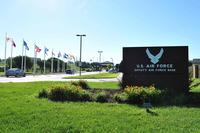
U.S. Navy officials insist the F-35 Joint Strike Fighter won't bust its budget, despite persistent rumors that the $300 billion acquisition program is on the cusp of a major cost overrun.
Capt. Wade Knudson, the Lightning II's development manager, said the plane's development costs are in line with earlier projections. Even if the first planes off the new production line cost more than expected, the long-term price tag isn't likely to move much, he told reporters last week. That's because the U.S. Air Force is on the books to buy 1,763 of the single engine fighters, anchoring a production line that is also due to crank out hundreds more aircraft for the Navy, Marine Corps and eight partner nations.
That isn't just program optimism, but should be reflected in the Pentagon's upcoming next round of official cost estimates, said Vice Adm. David Venlet, head of Naval Air Systems Command, in an interview. He rejected Capitol Hill talk that the program is on the cusp of a so-called Nunn-McCurdy breach, a cost overrun that would trigger a lengthy review and program restructuring. "I don't expect them to probably have numbers in it that would cause a Nunn-McCurdy. I believe what they're saying," Venlet said.
The verdict will come out in coming weeks, when the Pentagon releases its next "selected acquisition report" data on weapons costs. Already, however, audit agencies are raising red flags.
"We believe that JSF costs will likely be much higher than reported. The estimates do not include all costs," the Government Accountability Office said this month in a new report that called current projections "optimistic" and "not well supported". GAO said the required total investment now approaches $1 trillion, including maintenance costs, and it urged the Pentagon to take a realistic look at just how big the coming bills will be, given the Lightning II's "unprecedented" demands on the federal budget.
Critics say that expense should prompt a second look at cheaper alternatives, like a new order of Lockheed Martin's F-16 fighters or the latest models of the F/A-18 Super Hornet. Partner nations also might think twice, particularly if an electronic attack version of the F/A-18 is approved for export.
But Lockheed Martin counters that the stealthy F-35 will prove itself over decades of service, as it takes over roles currently performed by a wide variety of existing aircraft. The F-35 will be a bomber and a spy plane, as well as an air-to-air fighter. Its triple-play design will offer flexibility along with maintenance-saving commonality, said Steve O'Bryan, a former Navy fighter pilot who now handles F-35 business development for Lockheed Martin.
The F-35 will come in three versions, all produced on the same production line and able to use the same engines. A version of the basic model, a conventional takeoff and landing plane, is now in flight testing at Lockheed Martin's Fort Worth plant. The second version is a short-takeoff, vertical landing (STOVL) model sought by the Marines and the U.K., and the third version is an aircraft carrier model for the U.S. Navy.
Design differences among the three variants have brought more headaches than initially expected. Engine modifications for the STOVL have become a development challenge. Also, the Navy version has required a bigger wing, so the plane can fly long distances and also stay airborne at slow speeds near aircraft carriers. Even the basic plane has had its snags -- for example, wing bulkhead production issues have caused the first planes to be built "out of sequence" from the production plan, which is a significant hurdle for builders. Still, Lockheed Martin says it's making progress on all three versions and doesn't expect any major delays to result.
That's good news for the Navy, said Vice Adm. Venlet. "We've got to be deliberate about getting it here so it's got the capability we need when it gets here," he said. Patuxent River Naval Air Station, where Venlet is based, is due to get its first STOVL F-35 by the end of this year, assuming the plane sticks to its current schedule. Lockheed Martin will handle the initial test flights this summer, but the Navy will handle the jump jet's first vertical operations. Venlet said that testing will be "busy and noisy", but very welcome.
"We need it and we need it bad," Venlet said. "We need the Joint Strike Fighter. We covet that capability. It's going to be great."
-- Rebecca Christie









